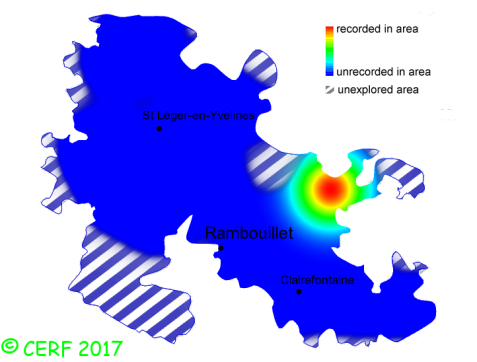common name(s) : Inkstain Bolete, Blackening Bolete
New classification: Basidiomycota/Agaricomycotina/Agaricomycetes/Agaricomycetidae/Boletales/Boletaceae
Former classification: Basidiomycota/Homobasidiomycetes/Agaricomycetideae/Boletales/Boletaceae/Boletoideae
[ section:Appendiculati ]
synonyms: Cyanoboletus pulverulentus, Xerocomus pulverulentus
edibility : edible, good
|
|
|
The cap is variable in colour: tawny-brown to pale brown, sometimes with reddish or olivaceous shades. It turns blue then black when touched., fleshy, hemispherical at first then convex, expanded to depressed at the centre.
The cap surface is hardly peelable, dry, finely downy then smooth, matt to shiny.
The cap margin is thin, regular, concolorous, partly covering the tubes.
The stem is sturdy, full and firm, thin, cylindrical, rooting and sometimes curved. It is pale lemon yellow at the top, purple brown to vinaceous red below, staining with dark blue (then brown) when touched. Its surface is finely flocculose or dotted, never with a network. The mycelium at its base is yellowish white..
The flesh is thick, a bit soft in the cap, lemon yellow to bright yellow, sometimes with shades of red in the stem base. It is turning blue instantly and intensely when cut and exposed to air, then becoming later green-blue, and eventually brown; its taste is mild; the odour is weak, fruity;
The tubes are adnate, sometimes gilled very close to the stem, easily removed from cap, short (6-10mm). They are pale yellow to lemon yellow then olivaceous yellow, turning strongly and instantly blue when cut.
The pores are rather large (0,6-1mm), angular, simple or composed (containing smaller pores inside), lemon yellow then olive green to ultimately dark brown. They turn instantly dark blue when pressed, then blue-black and eventually rusty.
The spore print is olive brown.
It grows in broad-leaved woods, but also with conifers, in well lit areas (wood edges, paths, clearings), on sandy soils, sometimes in parks or gardens, solitary or in small troops, with oak, beech, spruce, chestnut.
The fruiting period takes place from July to November.
| Dimensions: | width of cap approximately 7 cm (between 3 and 11.5 cm) |
| | height of stem approximately 8 cm (between 3 and 13 cm) |
| | thickness of stem (at largest section) approximately 15 mm (between 8 and 35 mm) |
| | spores : 10-15 x 4,5-5 microns, ellipsoid to almost spindle-shaped |
Chemical tests : The flesh turns ochre when in contact with ammonia.
Distinctive features : flesh turning intensely blue when cut or bruised; yellow and large pores; stem yellow towards top, dotted with red, rooting
Boletus pulverulentus is rare and confined in the forest of Rambouillet, and is infrequent, more generally speaking
.
|  | | Above : distribution map of Boletus pulverulentus in the forest of Rambouillet |
|